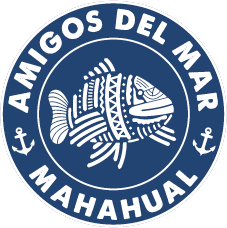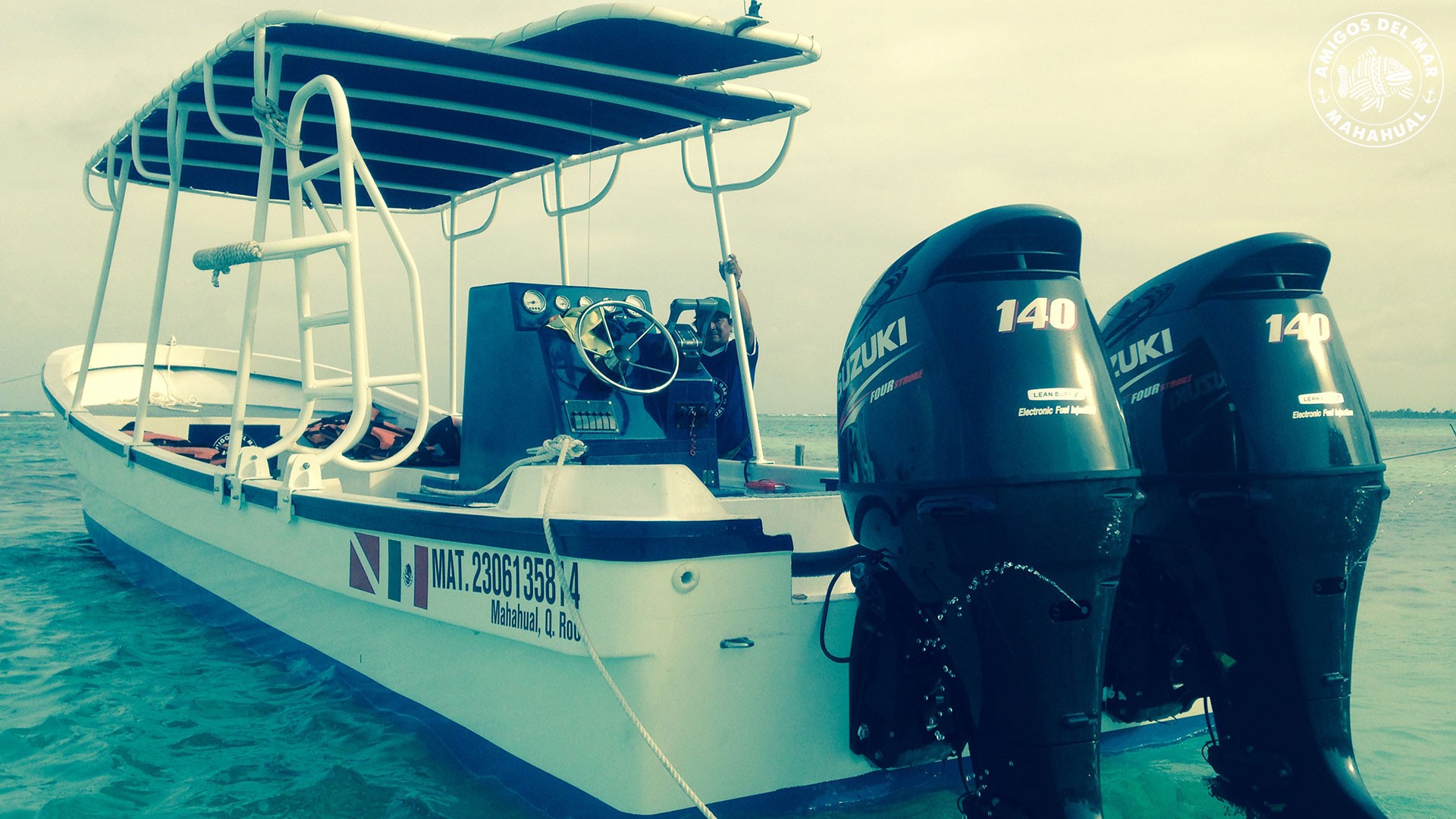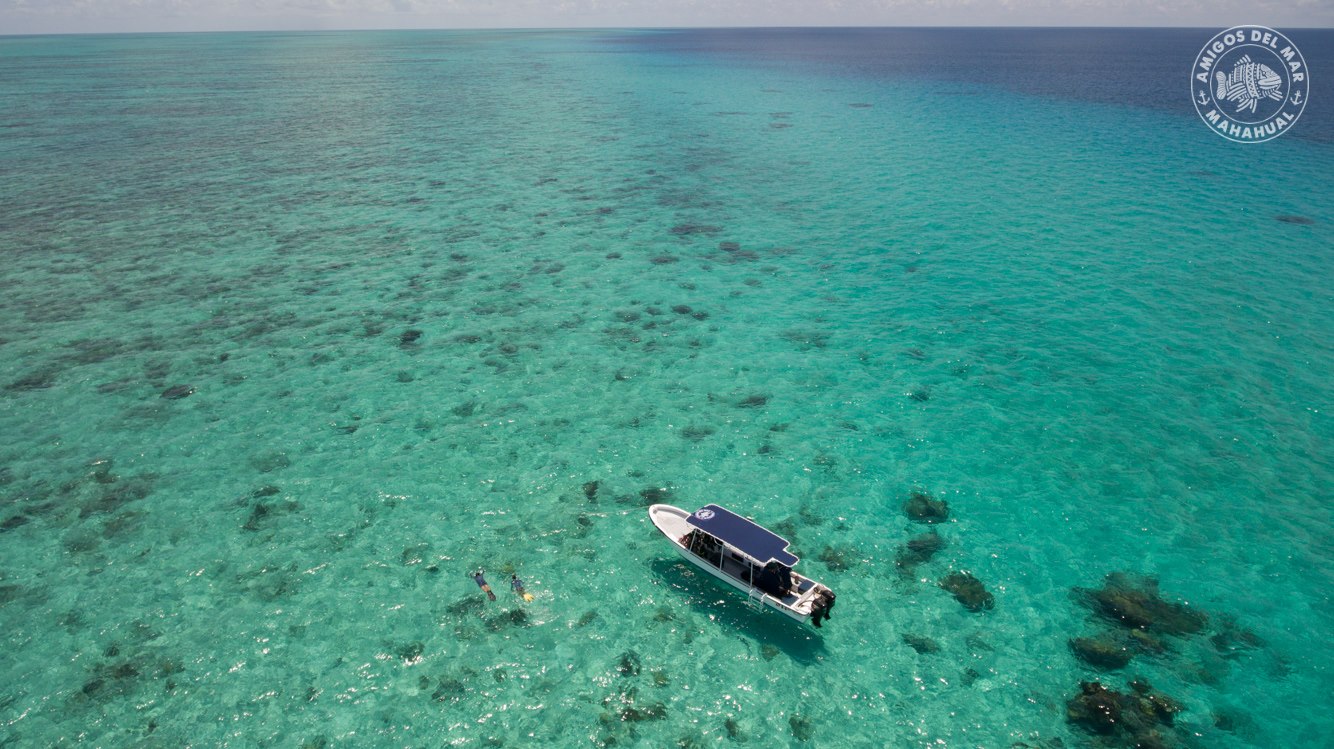Diving in Mahahual

The reefs around Mahahual offer superb Caribbean diving, and due to being a little off the beaten track, divers will enjoy a pristine quality of reef as well as usually having each dive site to themselves. Not only are the reefs healthy but the topography varies dramatically from walls to canyons to coral gardens, a diversity not seen anywhere else in the Mexican Caribbean.
There’s a rich variety of marine life to be found in Mahahual, including eagle rays, lobsters, groupers, barracudas, snappers and all three different Caribbean turtles, to name just a few species. In May it’s mating season for loggerhead turtles and so the giant males make their way close to shore. Some of them are the size of a small car, and always make for an incredible and memorable encounter. Occasionally dolphins and sharks also visit the
Divers are spoilt for choice as there are hundreds of dive sites scattered along 60 kilometres of coast heading north to the Sian Kaan Biosphere Reserve and another 42 kilometres south to Xcalak Marine Park. There are also over 15 sites just a short distance from town for those divers who prefer short boat rides. The variety of dives sites available makes this small fishing village a very special destination for divers.
There’s a rich variety of marine life to be found in Mahahual, including eagle rays, lobsters, groupers, barracudas, snappers and all three different Caribbean turtles, to name just a few species. In May it’s mating season for loggerhead turtles and so the giant males make their way close to shore. Some of them are the size of a small car, and always make for an incredible and memorable encounter. Occasionally dolphins and sharks also visit the
Divers are spoilt for choice as there are hundreds of dive sites scattered along 60 kilometres of coast heading north to the Sian Kaan Biosphere Reserve and another 42 kilometres south to Xcalak Marine Park. There are also over 15 sites just a short distance from town for those divers who prefer short boat rides. The variety of dives sites available makes this small fishing village a very special destination for divers.
Mahahual Dive Sites

40 Cañones
This is a wall dive with a difference as there are multiple openings, or canyons, in the reef. You’ll notice them when descending at the start of the dive, swimming to the outer section of the wall. From here it’s possible to explore down some of the canyons where lobsters and moray eels reside along with angel fish and trunk fish sheltering from the current. After each opening explored you’ll shallow up again and head to the outer wall until the next appears. If you look closely you’ll spot tiny shrimps and crabs too, and maybe even a pipe fish hanging off some fire coral. It’s an extensive dive site with a lot to explore, whether you stay on the top of the reef at about 12 metres or venture into the canyons to a maximum depth of around 25 metres. Other aquatic life likely to be spotted are eagle rays, turtles, eels, eagle rays, blue wrasse, tarpon and snapper.
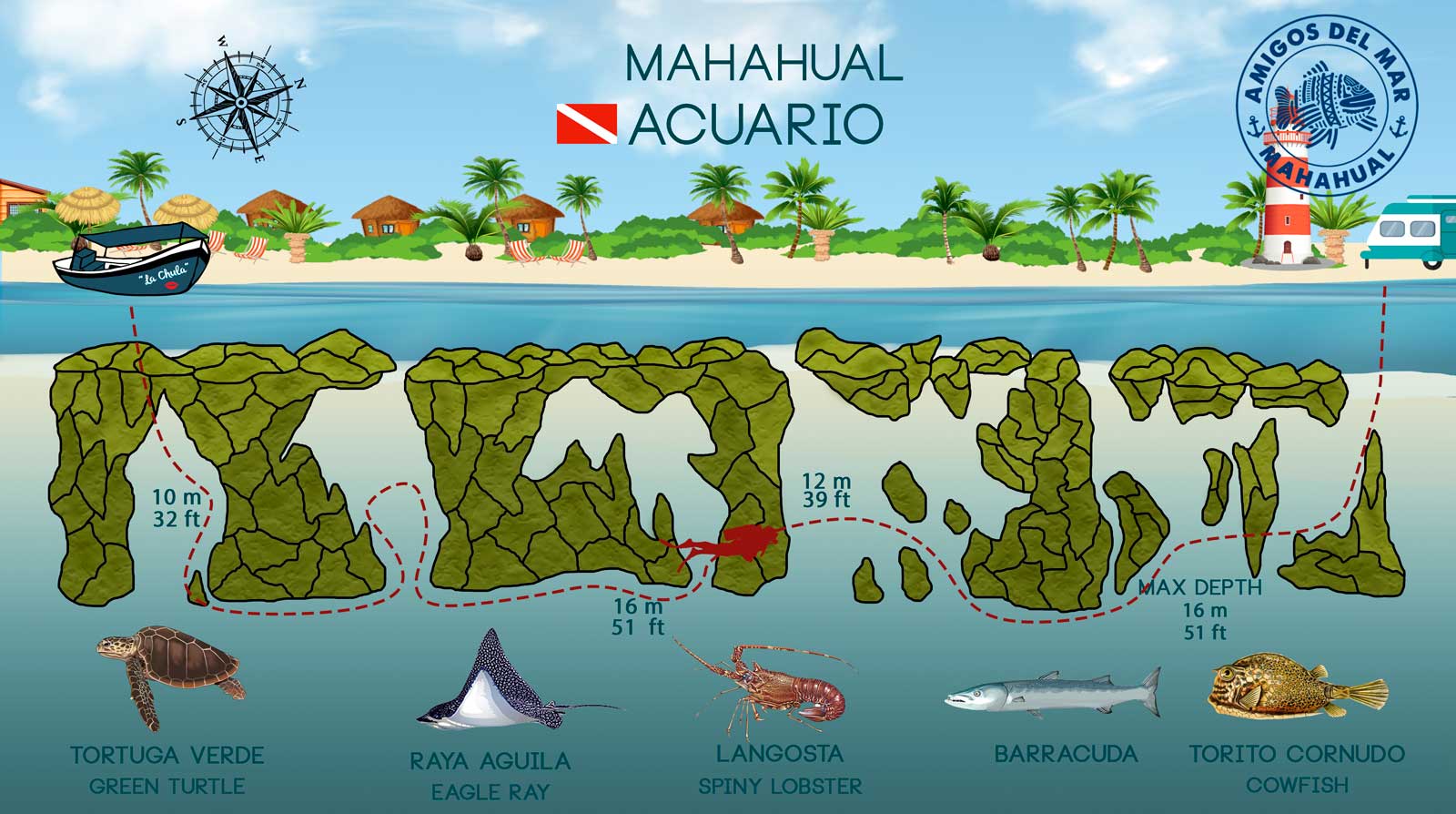
Acuario
Due to the shallow depth and easy conditions, this dive site is perfect for students and beginners and the descent can be done via a line. The wall starts at about eight metres and the sand below drops down to about 13 metres. After a while the wall splits into beautiful sections of coral. During the dive, it’s possible to spot eagle rays gliding past, turtles looking for some tasty sponge to eat, moray eels poking out of their little cave homes and sting rays blending into the sand. At certain times of year there are schools of blue chromis, wrasse and juvenile yellowtail barracuda. This site is great for explorers who like finding the little things, such as shrimps, hiding lobsters, baby eels and juvenile fish. If you plan to take a discover scuba or open water course this is where you’ll likely experience your first dive. For more advanced divers and depending on the current there is also the possibility to continue on to Escalones reef via an easy five-minute swim over the sand.
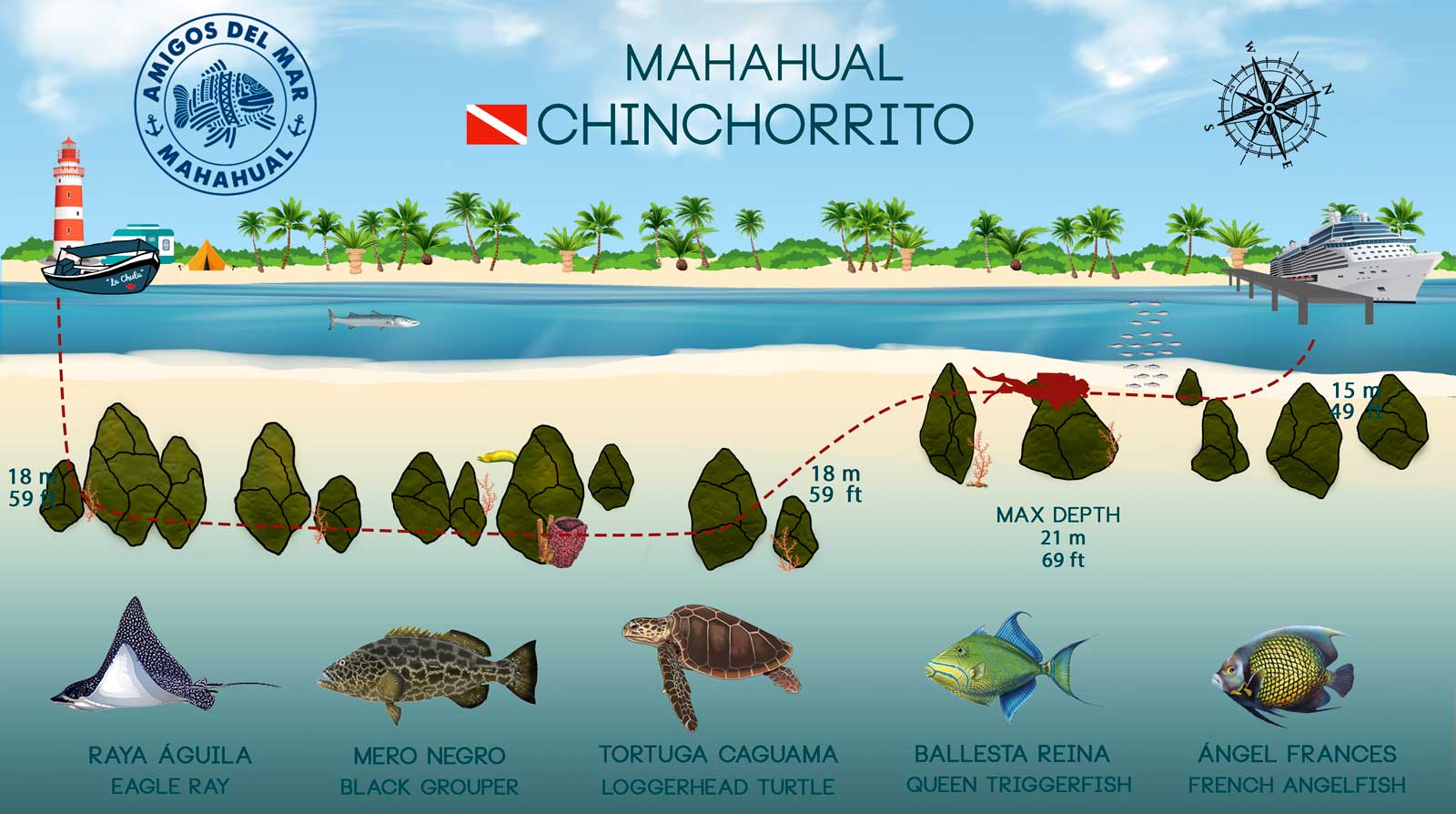
Chinchorrito
This site is a real favourite for both visitors to Mahahual as well as the dive professionals that work here. It’s called Chinchorrito because it feels like a little like Banco Chinchorro; the scenery being similar as well as the amount of marine life. It’s better suited to advanced divers, due to the maximum depth being 24 metres although it’s possible to stay as shallow as 18 metres and still enjoy the dive. The site stretches in a slight curve, following the current to the north and swimming from one coral formation to another where both soft and hard corals thrive, including many fans and barrel sponges. The diverse coral attracts numerous different types of fish including schools of blue wrasse, groupers, and barracudas, which are often lurking slyly and waiting for the chance to pounce on smaller fish. There are also frequent sightings of eagle rays, sting rays, spotted morays, and all three different types of turtles found in the area: green, hawksbill and loggerhead. The dive ends with a turn into the sand, swimming shallower and looking out for different types of rays including large southern sting rays and small yellow rays passing and looking for food.

Escalones
Located in front of the light house probably the most popular dive site of the reef wall right in front of Mahahual. Easy access from the boat sinking down to 15m where canyons form a beautiful landscape of coral structures. Depth ranges from 15 to 24m and we basically dive slowly zig-zag in-and-out in between the canyons which gives you the feeling of hoovering like an astronaut on the moon valleys. Not enough, Escalones comes with a broad variety of marine life, turtles, eagle rays, school masters, angel fish, barracuda, big groupers and HUGE green morey eels. Average depth is 17m of the dive and has no significant current. Just a quick zip out on our dive vessel less than 5 minutes from our dive shop, cant get better really.

Faro Viejo (Old Lighthouse)
This dive site is completey different than any other in the area. As we start the descend it all seems like a huge sandy area with some corals here and there but going down to the botton at only 12-14m we will start the dive at a beautiful coral reef with a maginficient overhang only a meter high or so with small hideout caverns all over the site. This is enough to have school master snappers and pork fish gathering below the over hangs in thousands. We literally keep diving along the overhangs and the school of snappers we push in front of us gets bigger and bigger. Visibitly due to all year long medium to strong currents is usually 20-30m. Currents always come with big predatory fish, a favourite site to see schools of barracuda, permits and horse eye jacks, solitary black groupers and occassionaly resting nurse sharks below the reef cracks. Hoovering from one reef to the other playing with the sea currents after about half of the dive we reach two beautiful arches where you can choose door a or b 😉 Faro Viejo is a shallow dive istes with max depth at 15m but nothing short of beauty and marine life.

La Rampa
The main reef wall stretches almost 3km in length in front of Mahahual and there is one place in particular where mother nature did us divers a gigantic favor. A huge canyon finger goes down from the wall to a depth over more than 40m. With mild currents usually, a spectacle is awaiting any diver. Huge schools of massive Cubera snappers gather in numbers to hunt in the currents, some a meter long and often mistaken for groupers because of their size. We start the dive decending the coral ramp down to 30m, stay there about 3-4 minutes watching the spectacle and then work our way up to 15-18m diving through openings in the canyons. The view from below up the reef is absolutely breath taking, sun light plays with different areas of reef system, giving it another incredible touch. Marine life oyu can encounter at La Rampa are Eagle rays, all 3 caribbean sea turtles, black groupers, cubera snappers and schools of doctor fish.

Los Arcos
Some 9km south of Mahahual, a deep dive site with a reef topography second to none. Huge canyons of coral gardens build up from 40m to almost 10m providing a surreal scenery. At the beginning of dive we will go deep down first to 30m passing through breath taking arches and passages. Afterwards we will work our way up to about 20m where we follow the huge canyons with a spectacular view of what is beneath and above. Some huge colonies of deep sea fans (black coral) are seen at the end of the dive, some 2-3m in diameter, a very rare finding in the Caribbean as they have been harvested and sold as souvenir for many years. A majestic dive site for the advances divers only, boosting amazing marine life like schools of barracudas, sea turtles, occasionally nurse sharks and all kind of Caribbean reef fish
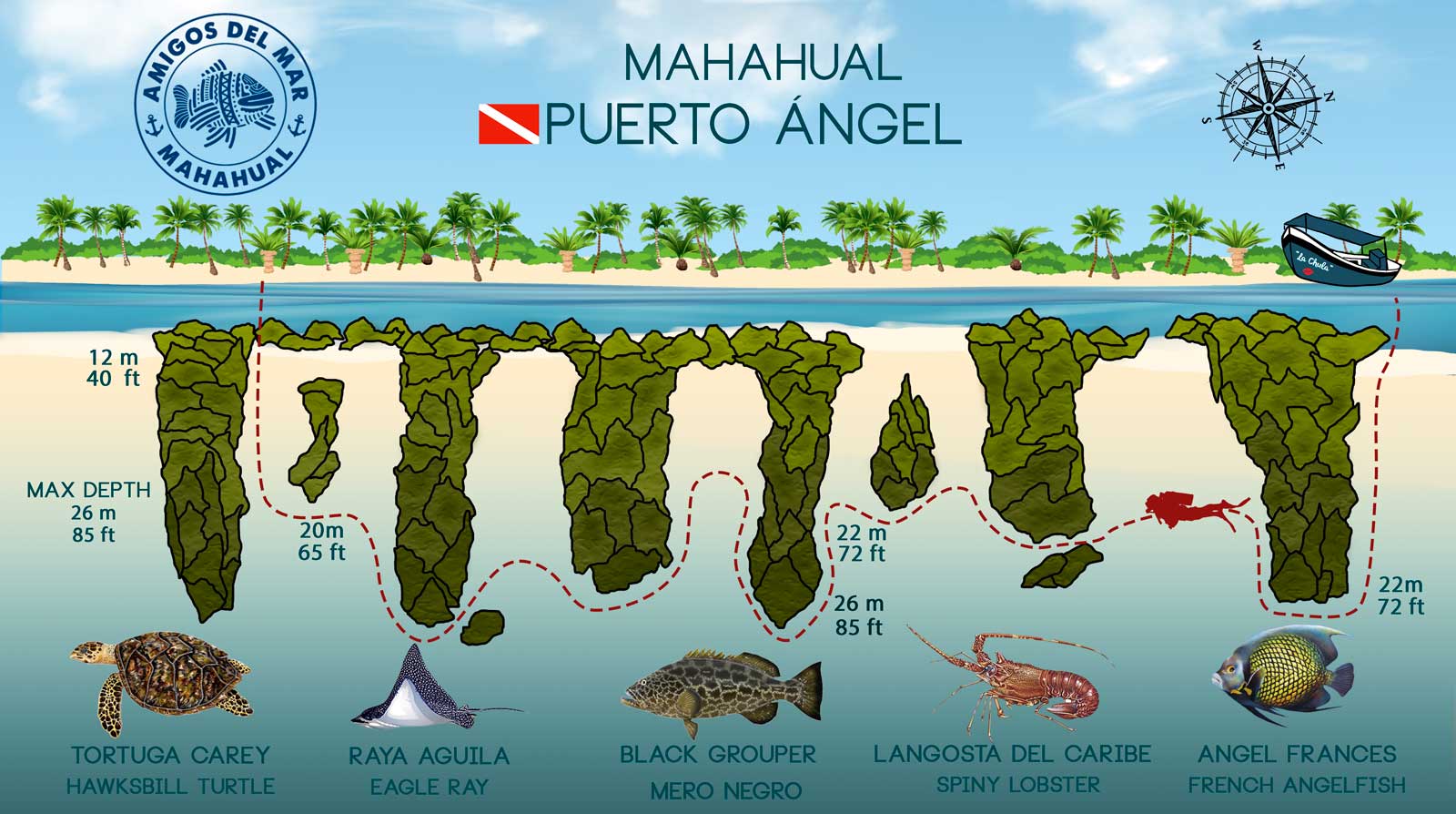
Puerto Angel
One of our ExplorDive sites, some 12km south of Mahahual for the ones who like to adventure and explore the unspoiled hidden gems of area. Puerto Angel is the perfect mix of coral gardens, sandy areas, and fascinating overhangs which will give you so much to look at. With a depth of between 12 and a maximum of 26 meters, you can hang around for almost hours and that gives you the chance of seeing a lot of different pelagics like Barracuda, Snappers, Turtles, Rays and Lobsters. Puerto Angel is also one of the favored spots for the Lionfish hunt.

Rio Bermejo (The Labyrinth)
The closest available dive site further south of Mahahual reef system, some 3,5km away from town. The Labyrinth is an exciting dive site, we go down to 26m and usually stay around 20m depth during the dive jumping from tip to tip of the canyons towards the open ocean. After about 15minutes into the dive you get several options and openings in the reef system and you gotta make your choice. One way in particular gets you through narrow cracks in the canyons which open up again to arena style reef tops with multiple exit ways again you can choose from, a beautiful labyrinth where you can prove your navigation skills under water. Canyons and cracks are full of spiny and Caribbean lobsters, eagle rays and southern sting rays shuffling in the sandy area below and sea turtles swim by as gentle giants. Reef fish is gathering at the tops of Canyons in great numbers as well.
Our Boat: "La Chula"
Name: La Chula
Boat: 33 feet fully customized Panga boat with canopy covering all seating area
Engines: 2x140hp Suzuki 4 Stroke Twin Engines with Lean Burn Technology
Equipment: 30 racks for dive tanks (+2 additional tanks at rear of the boat)
Capacity: Max. 14 divers plus crew
